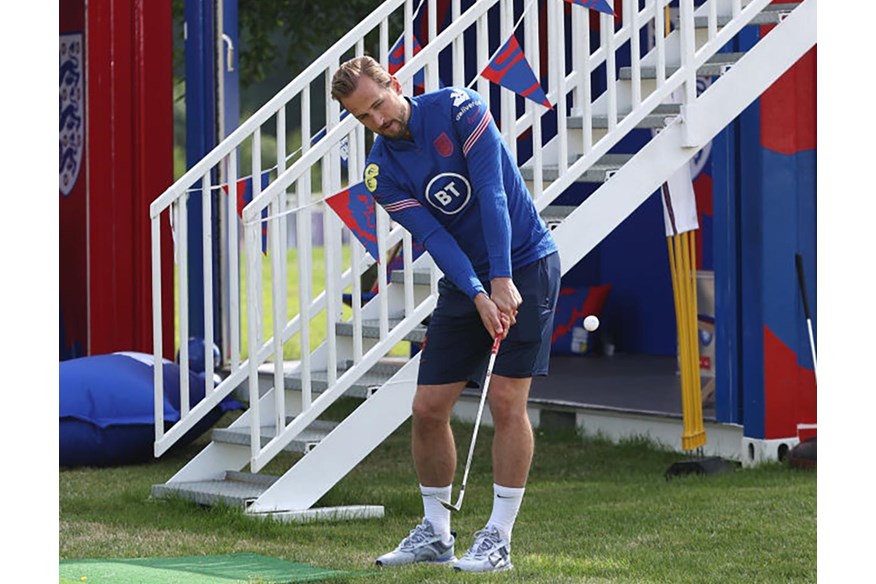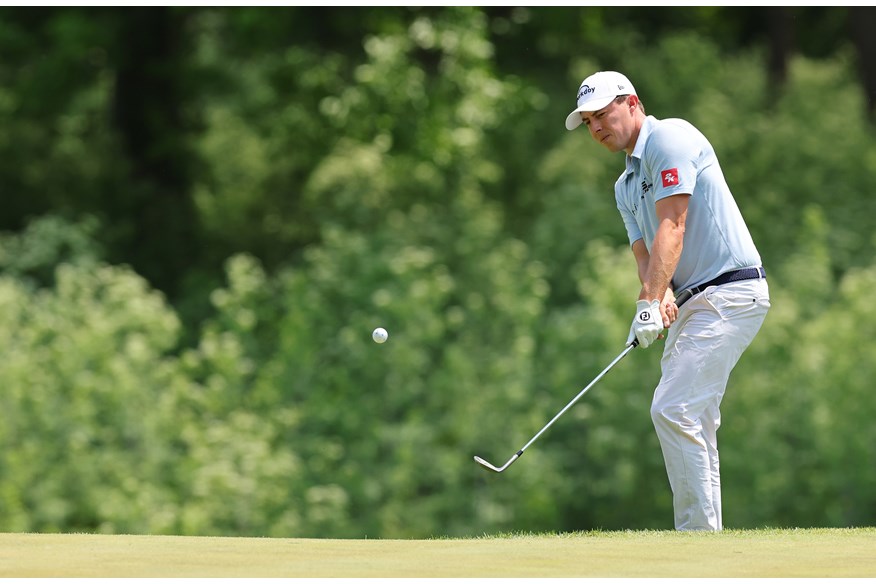Why does Matt Fitzpatrick chip cross-handed – and should you try it?
Last updated:
Struggling with your short game? Matt Fitzpatrick made one small change that helped him lead the PGA Tour in scrambling – and it might work for you too.
Chipping should be simple.
Compared to the full swing – with its coiling hips, weight shift, wrist angles, shoulder turns, shallowing shafts, and clubhead speeds north of 100 mph – chipping is the calm after the storm. There’s no need to load up, no need to chase distance. It’s basically just a putting stroke with a bit of loft. A small, controlled motion. Clean contact, a soft landing, and a predictable roll.
Trouble is: chipping is simple… until it isn’t.
One day, you’re stood over chip shots licking your lips, picking your landing spot and picturing the ball curling towards the hole at dead weight.
The next, it all feels complicated. Instead of brushing the turf and nipping your ball effortlessly, you’re chunking it two yards or blading it miles across the green. The soft hands turn twitchy. The quiet wrists get flippy. Your confidence takes a walk – and your short game goes with it.

When that happens, it’s easy to overcomplicate things in your hunt for a foolproof fix. Before you know it, you’re 100 YouTube videos deep and you don’t know whether you should be hinge-and-holding or doing a release 2. And you’re still not sure what a release 2 even is. You’re changing wedges; you’re wondering whether a few degrees more bounce might be the solution; you’re one click away from ordering a Ping ChipR.
But, sometimes, the solution is surprisingly simple – and it’s already right in your hands.
That’s why a handful of tour players, including U.S. Open champion Matt Fitzpatrick, have turned to an unconventional but quietly effective method: chipping cross-handed.
It might look strange, but this unconventional chipping grip is gaining traction – even at the highest levels of golf.
Those who embrace it have found it adds stability and simplicity back into their short game. For some, it’s completely reset how they approach short shots.
So what is cross-handed chipping, why are elite pros doing it, and – if you’ve lost your short game mojo – should you give it a shot?

How Matt Fitzpatrick ended up chipping cross-handed
Matt Fitzpatrick isn’t the kind of golfer who does things by chance.
It’s well known that he meticulously records every shot he hits, both in practice and in tournament play. He has done so since he was 15 years old, building a vast database of shot data that helps him understand his game and make informed decisions about his practice and course strategy.
So it won’t surprise you to hear that Fitzpatrick didn’t stumble onto cross-handed chipping as a gimmick.
“It was a drill that I’d done with my coach, Mike Walker, for a long time – just in the full swing,” he says. “I just found it more consistent. The ball comes off the face much more consistently. It’s the same every time. You know what’s coming. When I was chipping normally, it’s not like I had the yips. I was just getting a lot of inconsistency in the strike, and the release. I started doing it a couple of years ago in the rough, because I felt the technique really got the (club)head out.
After a few years chipping cross-handed from the rough, the data compelled Fitzpatrick to roll the technique out on fairway chips too.
“My stats chipping from the fairway weren’t that good, and I always felt comfortable doing it cack-handed from any lies. So he [Walker] said to give it a go, and it’s paid off.”
In the 2019-2020 season, chipping conventionally, Fitzpatrick ranked 138th for Strokes Gained Around the Green and was losing strokes to the field.
The following year, he started doing cross-handed chipping from the rough. He climbed to 97th for SG: Around the Green and was gaining a small amount of ground against his PGA Tour peers.
Then he went all-in on cross-handed chipping and the results speak for themselves.
In the 2021-2022, Fitzpatrick ranked first on the PGA Tour for scrambling, getting up and down 69.62% of the time. He ranked 7th for SG: Around the Green and gained almost half a shot per round.
“It’s worked really well for me,” he said. “My chipping stats are 100 percent better from this year compared to last.”
The 2022-2023 season showed it wasn’t a one-year wonder. Fitzpatrick ranked 13th in Scrambling and 31th in SG: Around the Green, gaining 0.238 shots per round.
Last season he wasn’t as hot, but he still gained strokes against the field and got up and down 61.76% of the time.
Perhaps more importantly, the technique helped Fitzpatrick to his first major victory, at the 2022 U.S. Open, plus the 2023 RBC Heritage on the PGA Tour and the 2023 Alfred Dunhill Championship on the DP World Tour.

Why Matt Fitzpatrick prefers chipping cross-handed
“To me, I can’t drag my hands across, because I’ll shank it if I go cross-handed,” he explains. “It helps me throw the head in, and I feel I have way more control over it. I just got so comfortable with it, and now I really like doing it.”
He’s not the only one
While Fitzpatrick is the most prominent player using cross-handed chipping on tour, he’s far from the only one.
The final group on day three of the 2025 PGA Championship was notable for the fact that two of the three lead players were chipping cross-handed. Jhonattan Vegas was the odd one out, chipping conventionally while playing alongside Fitzpatrick and Matthieu Pavon.
Chris DiMarco, known for his signature cross-handed putting style, was also one of the earliest advocates for trying the same technique around the greens. While he didn’t build his entire short game around it, he showed that a cross-handed grip could stabilize chipping mechanics for players prone to flipping or overusing their hands.
Tour players including Vijay Singh, Kevin Stadler, and Chris Couch have chipped and even hit bunker shots cross-handed, while Korn Ferry Tour player Josh Broadaway played cross-handed from tee to green.
Many other pros have been spotted testing the method during practice rounds or short game sessions. And among amateur and club golfers, it’s quietly gaining momentum.
Should you try it? Here’s what you need to know
Cross-handed chipping isn’t magic. It won’t automatically fix poor technique or bad decision-making. But it can be a valuable tool if you struggle with:
- Flipping your wrists at impact
- Inconsistent strike (fat, thin, or both)
- Tension in your trail hand
- Overactive hands in short swings
By reversing your grip – putting your lead hand lower on the handle – you promote:
- A flatter lead wrist through impact
- Less hand action and more shoulder/torso-driven movement
- A natural forward shaft lean, which helps with clean turf interaction
How to try it
If you’re curious, here’s how to ease into cross-handed chipping:
- Simply switch your hands on the grip. So, for right-handed golfers, your left hand will be lower than your right.
- Start with short, simple chips – something like a bump-and-run with a pitching wedge or 9-iron.
- Use your putting stance and motion. Feet close together, weight slightly forward, eyes quiet.
- Make sure your lead wrist stays firm through impact. The goal is to reduce flipping, not steer the club.
- Don’t rush. It’ll feel strange at first – especially with distance control. Stick with short shots before moving to longer ones. And don’t give up if your first few chips aren’t fantastic – it might take you a bit of time to get used to something that’s different to what you’ve done for years.
- Use it as a drill first. Even if you don’t adopt it full-time, cross-handed chipping can help retrain your hands to stay quieter.
Cross-handed chipping: a simple change but a major fix
Cross-handed chipping isn’t for everyone. Some players won’t need it. Others might try it and feel completely out of sync.
But if your short game feels like it’s unravelling – if you’re battling the yips, flipping your hands, or dreading routine chips – it might be the reset you need.
What makes it appealing is its simplicity. There’s no complicated overhaul or hours of technique work. Just a small grip change that forces your motion to become more stable, more connected, and more repeatable.
And if it’s good enough for Matt Fitzpatrick on major championship Sundays, it’s worth giving a go the next time you’re dreading a chip. You might just find your hands stay quieter – and your confidence gets a little louder.


